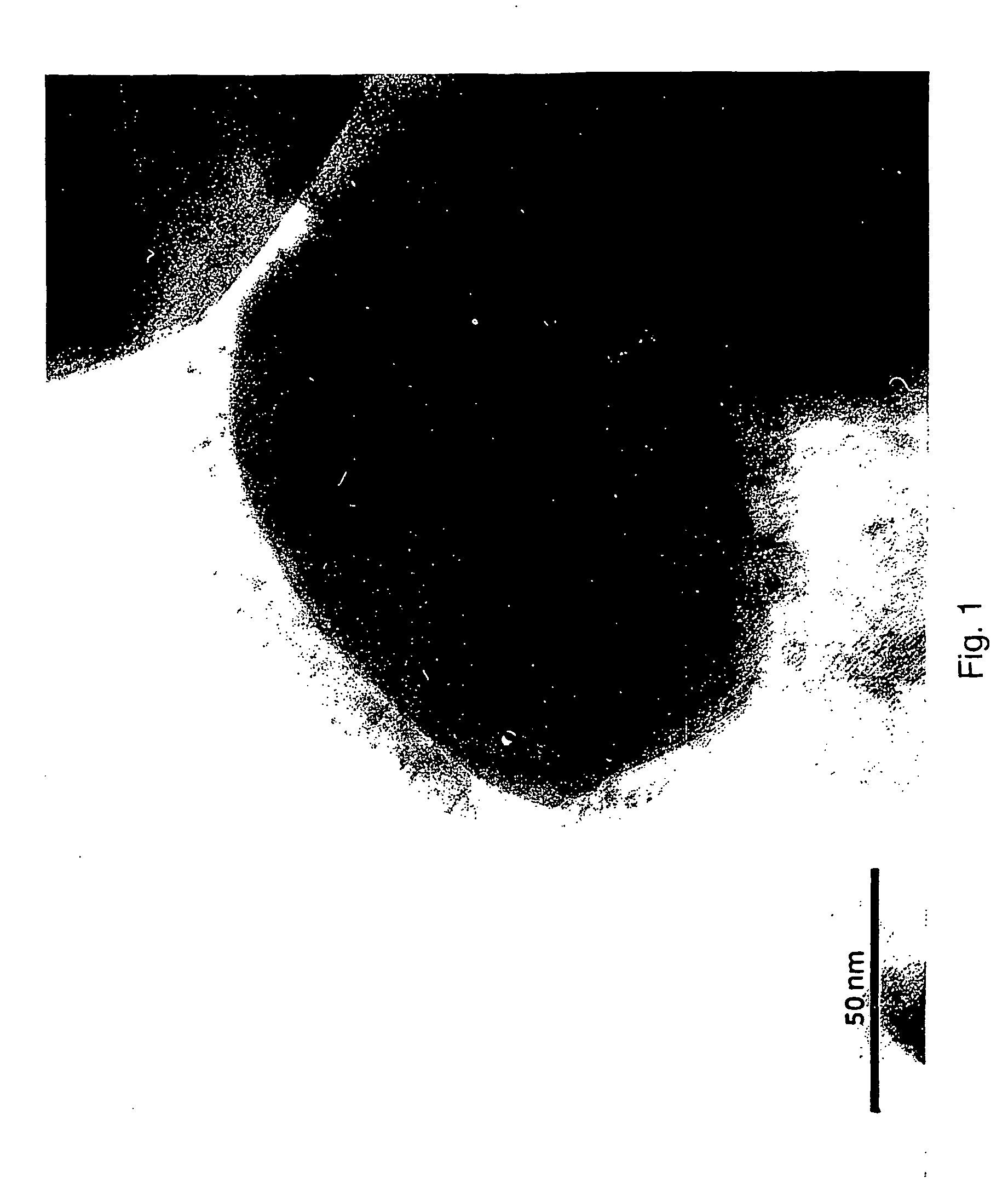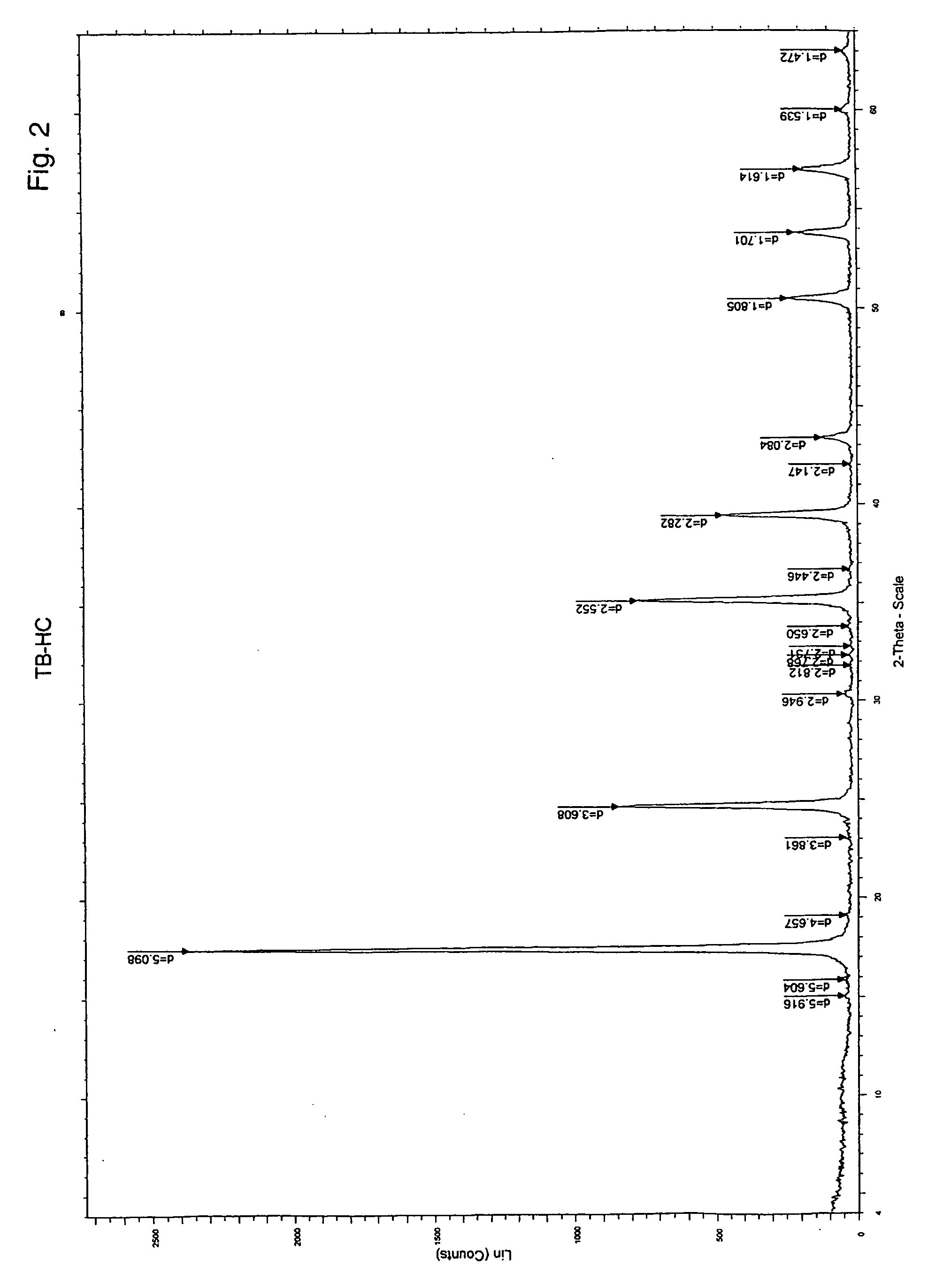Microparticles and methods for their production
a technology of microparticles and microparticles, applied in the field of microparticles, can solve the problems of low yield of endohedral metallofullerenes, inability to exchange molecules/materials, and inability to synthesis endohedral metallofullerenes,
- Summary
- Abstract
- Description
- Claims
- Application Information
AI Technical Summary
Benefits of technology
Problems solved by technology
Method used
Image
Examples
example 2
Synthesis of Carbon Encapsulated Iron Nanoparticles
[0052] Example 1 discloses the use of iron cyanide salt for the formation of an enclosed graphitic structure embracing an iron particle, but no control in particle size was achieved. Here we describe the use of a polar high boiling solvent (such as dioctyl ether of boiling point 287° C.) to dissolve the iron ferrocyanide compound at refluxing temperature (the compound is fairly soluble in the solvent at elevated temperature) giving intense blue colour solution. Iron-containing cyanide compounds are known to decompose at about 200-250° C. [23, 24]. In the presence of dissolved oxygen (air) achieved by purging the system with an air stream, the FeII(CN)64− of the FeIII4[FeII(CN)6]3 salt decomposes to Fe(CN)2-3O1-2 n− losing the cyanide species but simultaneously replacing them with oxygen species [23]. This will ultimately lead to precipitating of iron oxide that is insoluble in the solvent. FIG. 2 shows the powder X-ray diffraction ...
example 3
Synthesis of Carbon Encapsulated Nanoparticles Containing Iron and Rhenium
[0053] Example 2 shows that molecular oxygen from air can partially oxidise the iron cyanide compound in dioctylether at elevated temperatures. Adding a small quantity of sodium perrhenate (inorganic oxidant) to the mixture, as described in Table 1, can also oxidise the iron (II) cyanide species. Experimental details for typical synthesis are described below:
TABLE 1The starting materials. All the materials wereused as supplied by Aldrich.Act.Chemical NameChemical FormulaMol. Wt.Wt / gFeaturesSodiumNaReO42730.28WhitePerrhenateCrystalsIron (III)FeIII4[FeII(CN)6]3859.250.86Blue powderFerrocyanideDioctylether[CH3(CH2)7]2O242.4540 mlClear LiquidOleic acidCH3(CH2)7CH═CH(CH2)7COOH28220 ml—
[0054] The chemicals shown above, see Table 1, were mixed in a 3-necked round bottom flask using a magnetic stirrer bar. Before the mixture was heated up to 290° C. for 18 h, a gentle stream of nitrogen gas was bubbled directly int...
example 4
Synthesis of Carbon Encapsulated Nanoparticles containing Iron and Technetium
[0059] The procedure of Example 3 was repeated, using Na99TcO4 in place of NaReO4. The technetium was incorporated into the colloidal particles formed and appeared in the pyrolyzed graphitic shell particles. FIG. 11 is a TEM image of the spherical graphitic shell nanoparticles filled with Fe and 99mTc in the final product. FIG. 12 shows activity counts at different stages of the procedure, as now described. Activity assays were evaluated using gamma counter: 1 mL of 99mTcO4− of 5.19×10−11 mole dm−3 as the standard. This solution added to the mixture as described and allowed to reflux for 1 h (˜1 mL water collected with no radioactivity). Ethanol addition lead to precipitation as 1st pellet and the supernatant as 1st Sup. Repeated treatments produced 2nd Sup and 2nd pellet. After 1000° C. for 1 h the 2nd pellet produced solid as carbon. This sample washed with 4M HNO3, the supernatant as Acid Washing and th...
PUM
| Property | Measurement | Unit |
|---|---|---|
| diameter | aaaaa | aaaaa |
| diameter | aaaaa | aaaaa |
| thickness | aaaaa | aaaaa |
Abstract
Description
Claims
Application Information
 Login to View More
Login to View More - R&D
- Intellectual Property
- Life Sciences
- Materials
- Tech Scout
- Unparalleled Data Quality
- Higher Quality Content
- 60% Fewer Hallucinations
Browse by: Latest US Patents, China's latest patents, Technical Efficacy Thesaurus, Application Domain, Technology Topic, Popular Technical Reports.
© 2025 PatSnap. All rights reserved.Legal|Privacy policy|Modern Slavery Act Transparency Statement|Sitemap|About US| Contact US: help@patsnap.com



